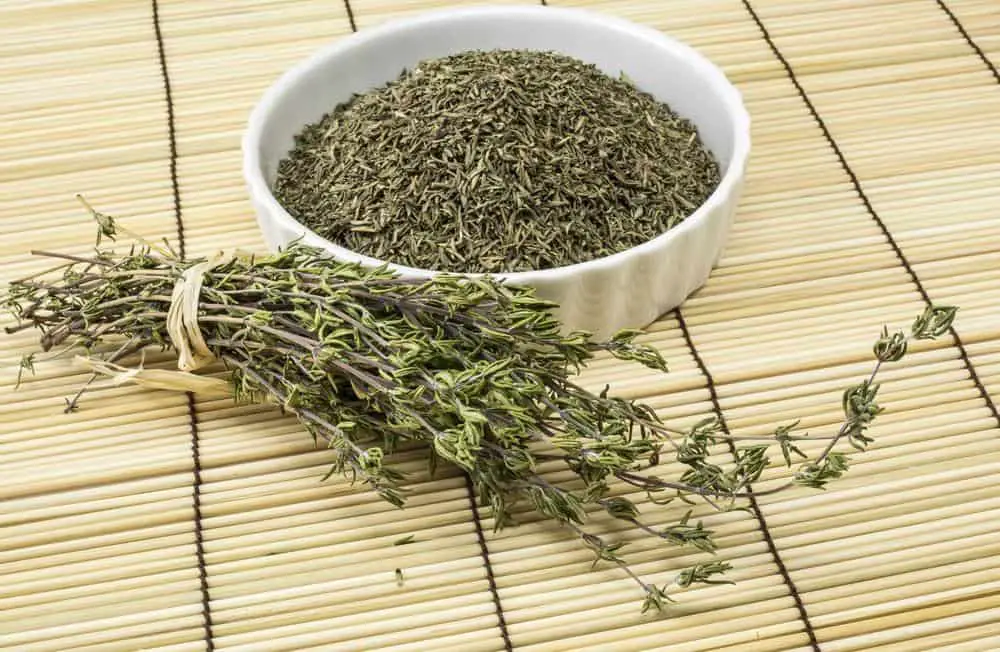Thyme is a versatile herb used to add flavor to many savory dishes. While fresh thyme has the best flavor, the dried form is more widely available and has a long shelf life. But what does dried thyme look like exactly? This guide covers the visual characteristics to help identify dried thyme.
Dried Thyme Leaf Description
The leaves are the most recognizable part of dried thyme They are typically greenish-gray in color. The leaves are very small, averaging 2-4 mm in length They have an elongated oval shape and pointed tips. The leaf edges tend to curl up slightly when dried. The leaves detach easily from the woody stems when rubbed. Dried thyme has a fine, fluffy texture almost like tiny grass clippings.
Dried Thyme Stem Description
The small stems are woody and straw-like. Fresh thyme has green stems but these turn beige or tan when dried. The stems are upright and branch out as the plant grows. Stems range from around 2-6 inches tall at maturity. They are slender, averaging 1 mm in thickness. The stems feel rigid and rough to the touch. Smaller side stems sprout off the main stem at intervals.
Common Visual Characteristics
Here are some common visual cues to look for when identifying dried thyme:
- Tiny grayish-green leaves with oval shape and pointy tips
- Detached leaves with tendency to curl under
- Fluffy feathery leaf texture in bunches
- Tan rigid, woody stems that branch upwards
- Stems around 2-6 inches long and very slender
- May include full sprigs with attached leaves and stems
- Sometimes just broken leaves removed from stems
Comparing Fresh vs. Dried Appearance
There are some key differences between the appearance of fresh and dried thyme:
- Fresh leaves are bright green while dried leaves are more grayish-green.
- Fresh stems are light green changing to tan when dried out.
- Dried leaf texture is fluffier and leaves detach more easily.
- Fresh thyme stands more upright while dried droops more.
- Dried leaves curl under more compared to flat fresh leaves.
- Stronger thyme aroma when fresh vs more muted when dried.
How to Use Dried Thyme
Dried thyme works well:
- As a rub on meats, fish and vegetables before cooking
- Mixed into stuffing, bread doughs, marinades and sauces
- Sprinkled on atop casseroles, soups, pasta, pizza and more
- Steeped in hot water for thyme tea
- Added to herbes de provence spice blends
- Infused in oils and vinegars
Varieties of Thyme
Thyme can be broken down by use: culinary and medicinal or ornamental.
Most of the time, ornamental thymes are used as ground cover. They are not even related to common thyme genetically, so don’t try to harvest your pretty bush! These species aren’t poisonous, but the flavor will be terrible. Wild thyme, also known as Mother of Thyme, gray-green silver thyme, honeybee food creeping thyme, and fuzzy wooly thyme are all types of ornamental thyme.
For cooking thyme, you want cultivars of the vulgaris species; don’t worry about what the name makes you think of. It’s just Latin for “common,” but this herb is anything but! This includes any thyme that’s called English or French, or Summer or Winter, which are also confusing names. It’s also known as garden thyme. Deep green, slightly shiny leaves grow in big, round mounds on this type, and light purple flowers bloom on them. Another type is Turkish thyme, which has small green leaves that grow close to the stem. There are also citrusy thymes like lemon, orange, and lime. If you rub the leaves of these subshrubs together, they will smell like these fruits. This makes them great for cooking.
Another great substitute is caraway thyme, which isn’t used very often but is popular in England for beef because it has a chemical called carvone that gives it that extra depth.
Fresh vs. Dry Thyme
Like all herbs, fresh thyme is more open and flavorful. Dried thyme, on the other hand, lasts longer and is more concentrated, though it needs to be warmed up to bring out its character.
Fresh thyme is sold in sprigs, which are short stems cut from the plant’s main stalk. It will stay fresh for about a week if you keep it dry and cool. After that, it will dry out or grow mold. The good news, however, is that it’s freezer-friendly, either stripped or on the stem.
If you prefer the convenience of dry thyme, you can find it in any spice aisle. As a matter of fact, it keeps its flavor better than many other herbs, so you can be sure that this simple solution won’t ruin your recipe. The exchange ratio couldn’t be simpler, either. It’s 1:1 by the teaspoon or tablespoon.
Fresh thyme to Dried Thyme
FAQ
How to identify dried thyme?
How do you know when thyme is dry?
Are ground thyme and dried thyme the same?
Is my thyme dead or dormant?
- The Ultimate Guide to Growing Strawberries in Raised Beds - August 8, 2025
- No-Dig Garden Beds: The Easiest Way to Grow a Beautiful Garden - August 6, 2025
- How to Protect and Preserve Wood for Raised Garden Beds - August 6, 2025

